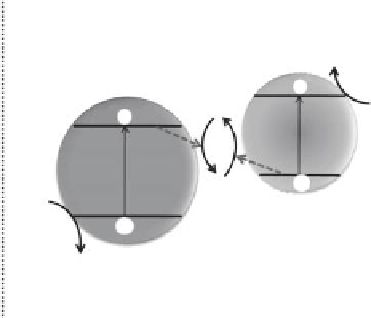Environmental Engineering Reference
In-Depth Information
CB quickly while the photoinduced holes remain in CdS. This facilitates the electron-hole
separation and thus improves photoreactivity.
11.3.4 Z-Scheme Photocatalytic System
As stated above, the energy level used for photocatalytic reaction seriously limits both
photocatalyst selection and visible light utilization. Semiconductors with narrow band gap
can be combined together to maintain the high redox potential of the photogenerated elec-
trons/holes and then drive speciic reduction/oxidation reactions separately via a multi-
photon (Z-scheme) process, which is inspired by the natural photosynthesis in green
plants. In the biomimetic Z-scheme photocatalytic system, two types of semiconductor
with different band structures are used to replace photosystem I (PS I) and PS II, respec-
tively. As shown in Figure 11.11, the photogenerated electrons in PS II are transferred to
the VB of PS I and then recombine with holes photogenerated at PS I, thus allowing the
oxidation and reduction reaction to take place at PS I and PS II, respectively. The advantage
of the Z-scheme photocatalytic system lies in extending the utilization range of solar spec-
tra due to the reduced energy requirement to excite each photocatalyst, and keeping the
photogenerated electrons/holes at a suficient reduction/oxidation potential to drive the
photocatalytic reaction, simultaneously facilitating the charge carrier separation. It is also
possible to use one side of the system to drive either a reduction or an oxidation reaction.
The critical factors in a Z-scheme photocatalytic system is to ind photocatalyst moieties
with proper electronic structure for driving oxidation and reduction reactions separately
and a reversible electron mediator acting as electron donor and acceptor in the respective
half-reactions. Similar to that occurring in green plants, an indirect Z-scheme mechanism
employing ionic redox couples (e.g., IO
3−
/I
−
, Fe
3+
/Fe
2+
, and
NO
−
/
) as electron media-
tor is proposed for such a coniguration, in which two isolated photocatalysts and redox
mediator coexist in the reaction solution.
38
These photocatalyst systems can facilitate some
dificult reactions, such as water splitting, to occur. Table 11.1 summarizes the typical
Z-scheme photocatalyst systems for water splitting under visible light irradiation.
Recent developments suggest that the performance of the Z-scheme systems strongly
depend on electron transfer processes between the two photocatalysts. The electron
NO
3
2
(a)
(b)
Photosystem II
Redox chain
Photosystem I
PS II
Redox chain
PS I
NADPH
CHI
P700*
Red
2
E
C
e
-
e
Ox
3
CHI
P680*
NADP
+
+
H
+
Ox
2
E
C
e
I
PQ
Cyt
Red
3
h
E
V
CHI
P700
hv
Red
1
PC
E
V
h
e
-
H
2
O
CHI
P680
hv
Ox
1
H
+
O
2
FIGURE 11.11
(See color insert.)
Z-scheme mechanisms in (a) the natural photosynthesis system and (b) semiconductor pho-
tocatalyst system.


